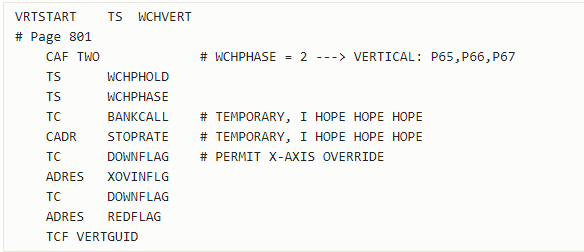Yesterday, reddit saw an explosion of discussion around the original Apollo 11 Guidance Computer (AGC) source code. The code in its entirety was uploaded on GitHub two years ago, thanks to former NASA intern, Chris Garry. And again it seems to have undergone significant updates this week looking at the timestamps on all the files in the repo.
This is a project that will always hold a special place for all software professionals around the world. This is the project that made ‘software engineering’ a real discipline.
What is AGC and why it mattered for Apollo 11?
AGC was a digital computer produced for the Apollo program, installed on board the Apollo 11 Command Module (CM) and Lunar Module (LM). The AGC code is also referred to as ‘COLOSSUS 2A’ and was written in AGC assembly language and stored on rope memory.
On any given Apollo mission, there were two AGCs, one for the CM, and one for the LM. The two AGCs were identical and interchangeable. However, their software differed as both the LM and the CM performed different tasks pertaining to the spacecraft. The CM launched the three astronauts to the moon, and back again. The LM helped in the landing of two of the astronauts on the moon while the third astronaut remained in the CM, in orbit around the moon.
The woman who coined the term, ‘software engineering’
The AGC code was brought to life by Margaret Hamilton, director of software engineering for the project. In a male-dominated world of tech and engineering of that time, Margaret was an exception. She led a team credited with developing the software for Apollo and Skylab, keeping her head high even through backlash. “People used to say to me, ‘How can you leave your daughter? How can you do this?” She went on to become the founder and CEO of Hamilton Technologies, Inc. and was also awarded the Presidential Medal of Freedom in 2016.
Hamilton is considered one of the pioneers of software engineering, credited for actually coining the term “software engineering”. She first started using the term during the early Apollo missions wanting to give software the same legitimacy as other disciplines. At that time, it was not taken seriously but over time software engineering has become an IEEE Standard.
What can we learn from the AGC code developers?
Understandably, the AGC specifications and processing power are very underrated as compared to the technology of today. Some still wittingly call it a calculator, instead of a computer. Others say, that the CPU in a microwave oven is probably more powerful than an AGC. Inspite of being a very basic technology in terms of processing power and speed, the Apollo 11 spacecraft was able to complete the first ever manned mission to the moon and back.
This is not just a huge testament to the original programming team’s ingenuity and resourcefulness but also of their grit and meticulousness. One would think such a bunch produced serious (boring) code that has flawless execution. Read between the (code) lines and you see a team that just enjoyed every moment of writing the code with quirky naming conventions and humorous notes inside the comments.
Back to the present
As soon as the code was uploaded on Github two years ago and even now, coders and software programmers all over the world, are dissecting it, particularly interested in the quirky English-descriptions of code explanations. People on Reddit are terming the code files as real programming that doesn’t rely on APIs to do the heavy lifting.
People are also loving the naming convention of the source code files and their programs which were 1960s inspired light-hearted jokes. For example, the BURN_BABY_BURN–MASTER IGNITION ROUTINE for the master ignition routine, and the PINBALL_GAME_BUTTONS_AND_LIGHTS.agc for keyboard and display code. Even the programs are quirky.

The LUNAR_LANDING_GUIDANCE_EQUATIONS.s, file ended up having two temporary lines of code as permanent.

You can read more such interesting reddit comments. However, a point worth noting is that Margaret and by extension, women in tech, are conspicuously missing in this rich discussion. We can start seeing real change only when discussion forums start including various facets of the tool/tech under discussion. People behind the tech are an important facet, and more so when they are in the minority.
You can also read The Apollo Guidance Computer: Architecture and Operation the inside scoop on how the AGC functioned, what kind of design decisions and software choices the programmers had to made based on the features and limitations of the AGC among other insights.
The github repo for the original Apollo 11 source code also contains material for further reading.
Read Next
Is space the final frontier for AI? NASA to reveal Kepler’s latest AI backed discovery
NASA’s Kepler discovers a new exoplanet using Google’s Machine Learning
Meet CIMON, the first AI robot to join the astronauts aboard ISS










![How to create sales analysis app in Qlik Sense using DAR method [Tutorial] Financial and Technical Data Analysis Graph Showing Search Findings](https://hub.packtpub.com/wp-content/uploads/2018/08/iStock-877278574-218x150.jpg)



Re redditor top comment:
It is much better to link the original website this GitHub repository comes from: http://www.ibiblio.org/apollo/
It has the most extensive AGC/AGS/LVDC/Gemini-related documentation, source code, and emulators.
They have a GitHub repository as well: https://github.com/virtualagc/